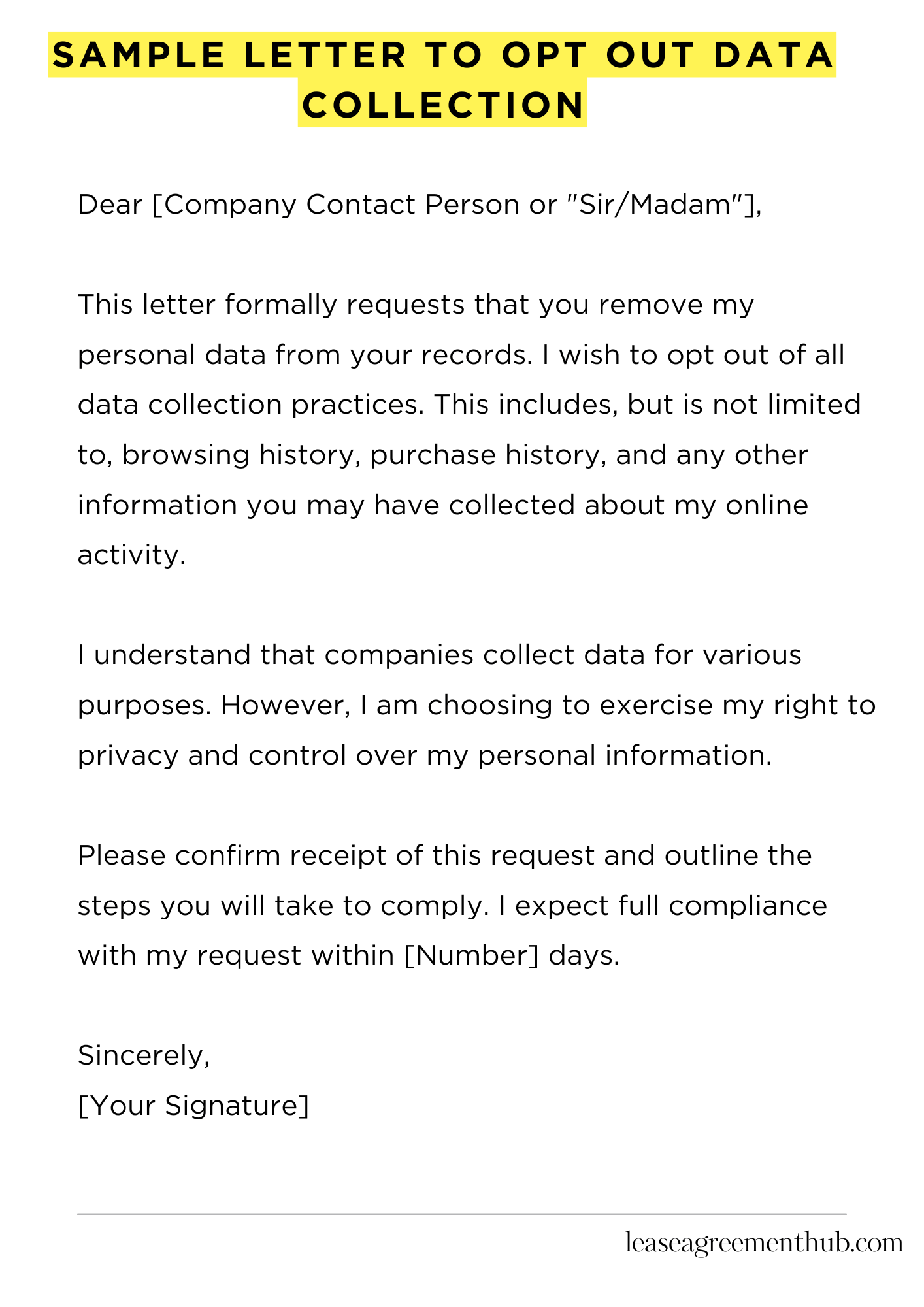A sample letter to opt out of data collection helps you formally request a company stop collecting your personal information. It protects your privacy.
This article gives you ready-made letter examples. These are templates you can easily adapt. They’ll make writing your own letter much simpler.
We provide various samples. You can choose the best one for your situation. Use them as a starting point.
Sample Letter to Opt Out of Data Collection
[Your Name]
[Your Address]
[Your Phone Number]
[Your Email Address]
[Date]
[Company Name]
[Company Address]
Dear [Company Contact Person or “Sir/Madam”],
This letter formally requests that you remove my personal data from your records. I wish to opt out of all data collection practices. This includes, but is not limited to, browsing history, purchase history, and any other information you may have collected about my online activity.
I understand that companies collect data for various purposes. However, I am choosing to exercise my right to privacy and control over my personal information. I want to ensure my data is no longer used for marketing, analytics, or any other purposes.
Please confirm receipt of this request and outline the steps you will take to comply. I expect full compliance with my request within [Number] days. I look forward to your prompt response and confirmation of the deletion of my data.
Sincerely,
[Your Signature]

How to Write a Sample Letter to Opt Out of Data Collection
Understanding Data Collection Practices
Before penning your missive, thoroughly scrutinize the organization’s privacy policy. Identify precisely what data they collect, how they utilize it, and their legal basis for doing so. This due diligence empowers you to craft a targeted and efficacious letter. Knowing your rights is paramount.
Crafting a Compelling Salutation
Begin with a formal salutation. Avoid informality. “To Whom It May Concern” is acceptable if the recipient’s name is unavailable. Specificity is key; a generic greeting weakens your message’s impact. Consider a personalized salutation if you have a contact person’s name.
Articulating Your Opt-Out Request
Clearly state your intention to opt out of data collection. Use unequivocal language, leaving no room for misinterpretation. Phrases like “I hereby request the cessation of all data collection pertaining to my person” are highly recommended. Be assertive, but maintain a courteous tone.
Specifying Data Types
Explicitly list the types of data you wish to have removed. Don’t be vague. Mention personal identifiers, browsing history, purchase records, or any other specific data pertinent to your situation. The more precise you are, the more effective your request will be. Ambiguity invites obfuscation.
Requesting Confirmation and Data Deletion
Request confirmation of your opt-out request. Ask for written acknowledgment of their receipt and action on your request. Demand the deletion of your data, specifying a reasonable timeframe for completion. This ensures accountability and provides a record of your action. This is not merely a request; it’s a demand for adherence to regulations and privacy standards.
Maintaining a Professional Tone and Structure
Maintain a professional and formal tone throughout the letter. Avoid emotional language or accusatory statements. Structure your letter logically, using clear paragraphs and concise sentences. A well-organized letter demonstrates your seriousness and respect for the process. Clarity begets efficiency.
Concluding Your Letter and Following Up
Close your letter with a professional closing, such as “Sincerely” or “Respectfully,” followed by your full name and contact information. Keep a copy of the letter for your records. Follow up if you don’t receive a timely response. Persistence is often necessary to secure desired results. Don’t hesitate to escalate the matter if needed.
FAQs about sample letter to opt out data collection
What information should I include in my opt-out letter?
Your letter should clearly state your desire to opt out of data collection, specify the type of data you wish to have removed (e.g., personal information, browsing history, location data), and identify the entity from which you are opting out. Include your full name and any relevant account numbers or identifiers. Keep a copy for your records.
To whom should I address my opt-out letter?
Address the letter to the specific company or organization collecting your data. If unsure, check their privacy policy or website for contact information, often including a designated data protection officer or privacy department.
What format should my opt-out letter be?
While there’s no legally mandated format, a clear, concise, and professional tone is recommended. A simple letter format works well. Avoid overly aggressive or emotional language. Maintain a polite and respectful tone throughout.
What if I don’t receive a confirmation of my opt-out request?
If you don’t receive confirmation within a reasonable timeframe (typically a few weeks), follow up with the organization via phone or email, referencing your initial letter. Keep records of all communication.
Can I opt out of data collection from all companies at once?
No, you must send a separate opt-out request to each individual company or organization from which you wish to opt out of data collection. Each entity has its own data collection practices and procedures.
Related: